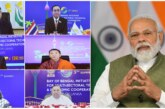Civil society has gained salience only in the last two couple of decades. A civil society needs to be interpreted much more broadly, in terms of citizen action for society, than is generally the case. This is not just about the contributions of traditional NGOs but encompasses any kind of citizens’ formation which looks at larger issues of social or political change — work that is not being done through the government or private sector.
Though theoretical paradigms of inter-linkages between civil society and the media are not well-defined, both aim at informing and reforming the people for their own well-being. Answer to the question whether media is a business or a government organ or a part of the civic sector varies from country to country and context to context. Regardless of its identity, media represents one of the most important stakeholders in the creation and maintenance of a functioning, vibrant civil society. Media sways public opinion. It helps influence and even creates the direction of social change.
Media serves as a tool that can help us put civil society principles into action. Access to accurate and timely information enables more effective participation of people with whom we work in decisions that affect their lives. Responsible journalism helps reinforce accountable behavior in society. The media can drive public perception – coverage can either create or erode support for the work of governments, civic organizations and businesses. A well-run public information campaign works with the media to raise public awareness of any number of issues from human rights to current social concerns.
Media can manifest itself in many ways – print, radio, television, the Internet. Media as an active stakeholder or an implementing partner can open the door to new opportunity and improved impact. Media affords an opportunity to spread a message, to reach broader audiences, to increase participation and to promote accountability. Informed people can discuss social problems and lay the groundwork for more peaceful change in their countries.
According to A. K. Shiva Kumar, a noted development economist, the media are much focused on information-gathering with the overriding concern to put out timely information. Civil Society, on the other hand, has more to do with public education in which information is, of course, the first step in awareness-building, but, beyond that, there is the business of influencing public reasoning and debate. Besides, media are driven are driven by concerns of topicality, and lack a long-term interest in systematically or strategically influencing policy.
In a vast country like India, media discourse is prone to be variegated. Anything that is distant in time and space does not make an impact for the media, while that is not the case with civil society groups. In the opinion of Shiva Kumar, while the media are definitely driven by the need for financial sustainability and they cannot do what a lot of civil society groups and NGOs can, or try to do, of managing on low budgets: “The way in which the media are organised, their motivations, and so on, make the compulsion of financial sustainability crucial. This means they always have to move on. They cannot afford to harp on a particular issue. This also means that the media fail to pick up silent deprivations, poverty and malnutrition.”
The nature of public discourse is a decisive factor in focusing media attention. Louder nature of public discourse attracts better media attention as had happened when the Right to Information and National Rural Employment Guarantee (NREG) Bills were being discussed, or when the CNG controversy hit Delhi, or when there was a public outcry against domestic violence, these issues did figure in the media. But given that the volume and quality of public debate in India is so poor, it may not be realistic to expect more from the media which are essentially reactive, not proactive.
This is what happens to scores of civil society organizations which are engaged in yeoman missions and seldom receive even a mention in the mainstream media. Recently, India Water Foundation, a New Delhi-based civil society, organized a Regional Workshop on Water Quality Monitoring Workshop in New Delhi in which participants from 22 countries of Asia and the Pacific, UN agencies, regional and international organizations, many departments of government of India and state governments took part. However, this momentous event found no mention in the media.
A close rapport between the civil society and the media is essential for the nation’s well-being. Syeda Hameed, Member of Planning Commission, regards civil society as an entity that articulates concerns that affect the entire community. However, she laments that ordinary people don’t know how to work the system and they need to be taught how to express and fight for their interests. It is here that Ms Hameed insists that the media should help in articulating these social concerns but this is not happening. The media, especially the mainstream media with their enormous powers of influence, either fail to articulate these concerns or articulate them in a way designed to cater to their own interests and drive up their TRPs. They thus end up ignoring concerns that are life and death matters for people.
In the opinion of Tarun Tejpal, Editor-in Chief of news magazine Tehelka, the fundamental difference between the media and civil society organisations is in terms of commercialism and social service; where the media today have become a purely commercial construct and the civil society, in contrast, is not — there is no money to be made out of the activities that civil society is involved in. I think that this has become. He further opines that ideally, civil society should be amplifying what the media do, and media should be articulating the concerns of civil society. But today this complementarity is not very evident.
Tejpal laments at the fact that recent decades have seen many political exposes but you will find it difficult to get five big exposes of corporate wrongdoing in that list. This journalistic atmosphere has been teeming and growing by the day. The Indian media constantly focus on soft targets and completely steer clear of hard targets. “So if television happens to get a rabbit in its cross hairs, it will run the rabbit down until it is dead. But it will never take on the hound, because the hound can hit back. So we run with the hounds and hunt the hares; that’s what we do, and we make a virtue of it.”
Sevanti Ninan, is columnist and author, feels that the media have been increasingly forced to reach out to civil society. She cites the example of television where there is a constant seeking out of data and opinion from those in the field, whether it is for a panel discussion or simply to keep programmes going. After all, civil society groups are the people with the data; they are the ones who interact with those on the ground and understand local issues. The media have to always seek out people who have done the groundwork for them. A civil society like National Election Watch has been constantly sending information to the media.
Ninan feels that civil society, too, needs the media. After all, anything it does, whether it is a time-bound intervention linked to the general election or something broader like dalit welfare, requires it to reach audiences and draw more people into its own work, something that is difficult to achieve without the media. So there is a potential partnership here. Of course, the media don’t critique themselves as rigorously as they should.
Close proximity between civil society and the media is described by Lysa John, Director, Global Call To Action Against Poverty, it is almost as if civil society is at the point where the media were some decades ago. She further illustrates this point by asserting that a number of media organisations came up during the nationalist movement and articulated important public concerns. Today, the media are much more commercial in their orientation — and not just in a negative sense because, after all, they need to sustain themselves. But they now no longer consider it necessary to speak or work for the poorest of the poor. In other words, it is almost as if civil society has now taken on the mantle the media once wore.
Lysa John laments that presently the media have a very simplistic understanding of civil society organisations — they end up over-simplifying their efforts or portraying them in very stereotypical ways. They project civil society groups either as harmless do-gooders or extremist elements that spell harm for society. Also, usually the media individualise effective civil society campaigns and attribute their success to the efforts of one great leader. These campaigns are never represented as a collective and professional effort.
She aptly sums up: “The media, for their part, may want to be seen as proactively engaging with a social cause. But the problem so far is that they have always looked at civil society as the implementing arm of a concept that their business counterparts have created. I think both the government and the media don’t realise that the most progressive, far-reaching and visionary ideas today come from civil society. The media are largely falling in line with the interests of the powerful. The only people who are thinking out of the box to transform lives and existing structures are the people who constitute civil society.”
Conclusion
In order to change societies and the relationships between them, it is necessary to change the media. This is not solely an issue of media content. It is an issue of changing the media system as a whole, as well as the organizations within it. Media reform, media democratization and communication rights movements are evolving on the grassroots level, in regional and transnational NGO networks and in international policy arenas.
A development civil society should have a well-thought-out strategy on partnering the media. A strategy that puts forward information and issues that would appeal to them. And because India is so big it makes no sense for an organisation to have a national strategy. The media are very differently developed in Chennai than they are in Jharkhand. So there is need to think through how one partners the media to take a particular issue forward. If media and civil society were to be partners, they could potentially be a very strong force. But we must also recognise that the resources that are driving the media today come from the commercial sector.
By Dr. Arvind Kumar, President, India Water Foundation



